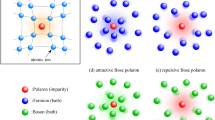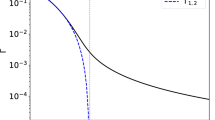Abstract
Loosely bound nuclei far from the stability region emerge as a quantum phenomenon with many universal properties. The connection between these properties and the underlying symmetries can be best explored with halo/cluster EFT, an effective field theory where the softness of the binding momentum and the hardness of the core(s) form the expansion parameter of a given perturbative approach. In the following I highlight a particular application where these ideas are being tested, namely capture reactions.
Similar content being viewed by others
References
Braaten E., Hammer H.-W.: Universality in few-body systems with large scattering length. Phys. Rep. 428, 259 (2006)
Bertulani C.A., Hammer H.-W., van Kolck U.: Effective field theory for halo nuclei: shallow p-wave states. Nucl. Phys. A712, 37 (2002)
Bedaque P.F., Hammer H.-W., van Kolck U.: Narrow resonances in effective field theory. Phys. Lett. B569, 159 (2003)
Higa R., Hammer H.-W., van Kolck U.: \({\alpha\alpha}\) scattering in halo effective field theory. Nucl. Phys. A809, 171 (2008)
Gelman B.A.: Narrow resonances and short-range interactions. Phys. Rev. C 80, 034005 (2009)
Phillips D.R., Hammer H.-W.: Electromagnetic properties of the Beryllium-11 nucleus in Halo EFT. EPJ Web Conf. 3, 06002 (2010)
Phillips D.R., Hammer H.-W.: Electric properties of the Beryllium-11 system in Halo EFT. Nucl. Phys. A865, 17 (2011)
Rupak G., Higa R.: Model-independent calculation of radiative neutron capture on Lithium-7. Phys. Rev. Lett. 106, 222501 (2011)
Fernando L., Higa R., Rupak G.: Leading E1 and M1 contributions to radiative neutron capture on lithium-7. Eur. Phys. J. A 48, 24 (2012)
Rupak G., Fernando L., Vaghani A.: Radiative neutron capture on carbon-14 in effective field theory. Phys. Rev. C 86, 044608 (2012)
Acharya B., Phillips D.R.: 19C in halo EFT: effective-range parameters from Coulomb dissociation experiments. Nucl. Phys. A913, 103 (2013)
Canham D.L., Hammer H.-W.: Universal properties and structure of halo nuclei. Eur. Phys. J. A 37, 367 (2008)
Canham D.L., Hammer H.-W.: Range corrections for two-neutron halo nuclei in effective theory. Nucl. Phys. A836, 275 (2010)
Rotureau J., van Kolck U.: Effective field theory and the Gamow shell model. Few Body Syst. 54, 725 (2013)
Ji C., Elster Ch., Phillips D.R.: 6He nucleus in halo effective field theory. Phys. Rev. C 90, 044004 (2014)
Lensky V., Birse M.C.: Coupled-channel effective field theory and proton- 7Li scattering. Eur. Phys. J. A 47, 142 (2011)
Ryberg E., Forssén C., Hammer H.-W., Platter L.: Effective field theory for proton halo nuclei. Phys. Rev. C 89, 014325 (2014)
Bertulani C.A., Gade A.: Nuclear astrophysics with radioactive beams. Phys. Rep. 485, 195 (2010)
Trache L. et al.: Asymptotic normalization coefficients for 8 B 7Be + p from a study of 8 Li 7Li + n. Phys. Rev. C 67, 062801 (2003)
Zhang X., Nollett K.M., Phillips D.R.: Combining ab initio calculations and low-energy effective field theory for halo nuclear systems: the case of \({{}^7{\rm Li}+n\to {}^8{\rm Li}+\gamma}\). Phys. Rev. C 89, 024613 (2014)
Zhang X., Nollett K.M., Phillips D.R.: Combining ab initio calculations and low-energy effective field theory for halo nuclear systems: the case of \({{}^7{\rm Be}+p\to {}^8{\rm B}+\gamma}\). Phys. Rev. C 89, 051602 (2014)
Kaplan D.B.: More effective field theory for non-relativistic scattering. Nucl. Phys. B494, 471 (1997)
Koester L., Knopf K., Waschkowski W.: Neutron scattering length of lithium and boron and their isotopes. Z. Phys. A 312, 81 (1983)
Angulo C. et al.: Experimental determination of the 7Be + p scattering lengths. Nucl. Phys. A 716, 211 (2003)
Weinberg S.: Effective chiral lagrangians for nucleon-pion interactions and nuclear forces. Nucl. Phys. B363, 3 (1991)
Kaplan D.B., Savage M.J., Wise M.B.: A new expansion for nucleon–nucleon interactions. Phys. Lett. B424, 390 (1998)
Kaplan D.B., Savage M.J., Wise M.B.: Two-nucleon systems from effective field theory. Nucl. Phys. B534, 329 (1998)
van Kolck U.: Effective field theory of short-range forces. Nucl. Phys. A645, 273 (1999)
Tombrello T.: The capture of protons by 7Be. Nucl. Phys. 71, 459 (1965)
Davids B., Typel S.: Electromagnetic dissociation of 8B and the astrophysical S factor for \({{}^7Be(p,\gamma){}^8{\rm B}}\). Phys. Rev. C 68, 045802 (2003)
Huang J.T., Bertulani C.A., Guimaraes V.: Radiative capture of nucleons at astrophysical energies with single-particle states. At. Data Nucl. Data Tables 96, 824 (2010)
Hammer H.W., Lee D.: Causality and universality in low-energy quantum scattering. Phys. Lett. B681, 500 (2009)
Hammer H.W., Lee D.: Causality and the effective range expansion. Ann. Phys. 325, 2212 (2010)
Tanihata I. et al.: Measurements of interaction cross sections and nuclear radii in the light p-shell region. Phys. Rev. Lett. 55, 2676 (1985)
Imhof W.L. et al.: Cross sections for the \({{\rm Li}^7(n,\gamma){\rm Li}^8}\) reaction. Phys. Rev. 114, 1037 (1959)
Nagai Y. et al.: \({{}^7{\rm Li}(n,\gamma)^8{\rm Li}}\) reaction and the S 17 factor at E c.m. > 500keV. Phys. Rev. C 71, 055803 (2005)
Blackmon J.C. et al.: Measurement of \({{}^7{\rm Li}(n,\gamma)^8{\rm Li}}\) cross sections at E n = 1.5−−−1340eV. Phys. Rev. C 54, 383 (1996)
Lynn J.E., Jurney E.T., Raman S.: Direct and valence neutron capture by 7Li. Phys. Rev. C 44, 764 (1991)
Izsak R. et al.: Determining the \({{}^7{\rm Li}(n,\gamma)}\) cross section via Coulomb dissociation of 8Li. Phys. Rev. C 88, 065808 (2013)
Stone N.J.: Table of nuclear magnetic dipole and electric quadrupole moments. At. Data Nucl. Data Tables 96, 75 (2005)
Author information
Authors and Affiliations
Corresponding author
Rights and permissions
About this article
Cite this article
Higa, R. Capture Reactions with Halo Effective Field Theory. Few-Body Syst 56, 761–766 (2015). https://doi.org/10.1007/s00601-015-1004-x
Received:
Accepted:
Published:
Issue Date:
DOI: https://doi.org/10.1007/s00601-015-1004-x




